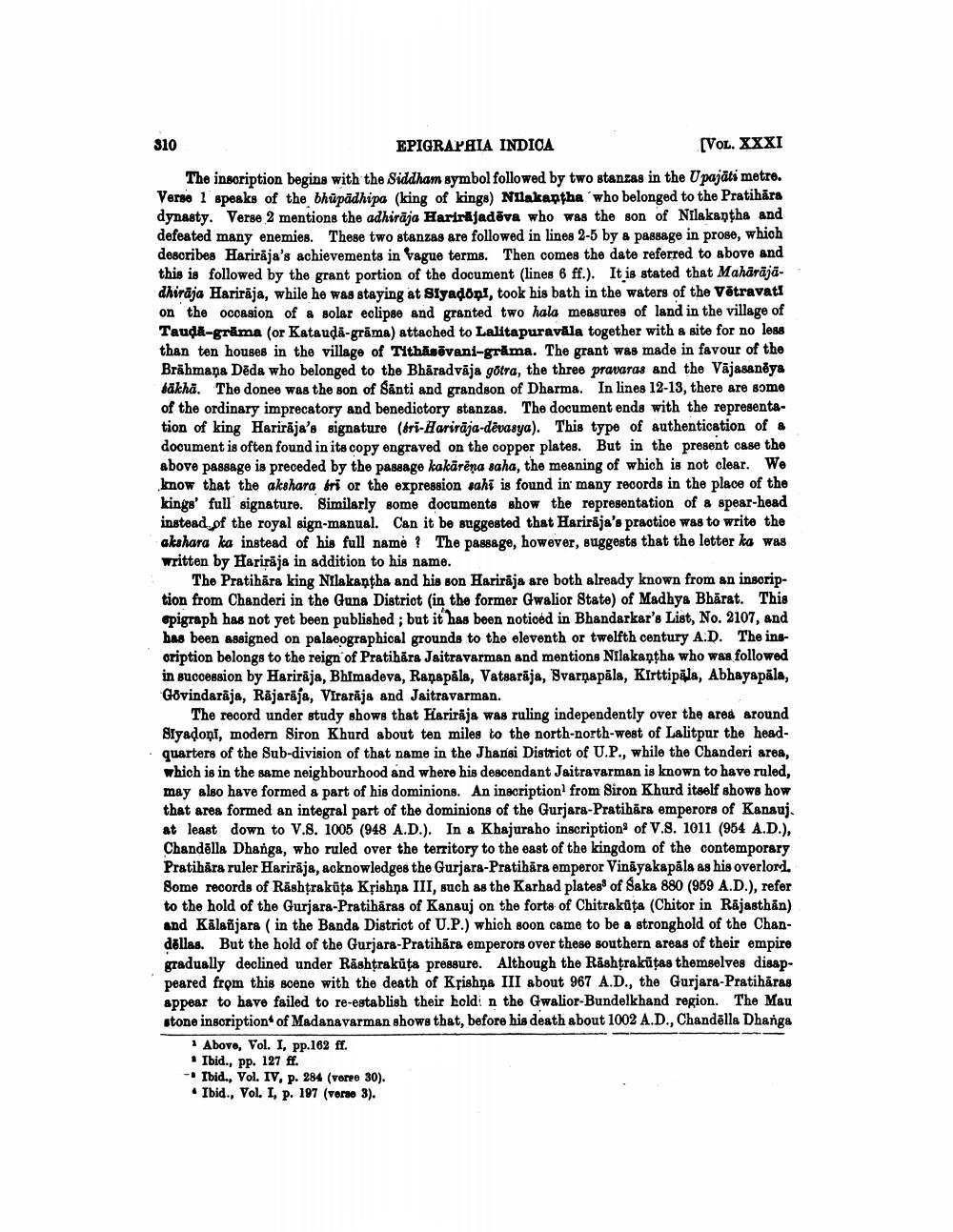________________
310 EPIGRAPHIA INDICA
[VOL. XXXI The inscription begins with the Siddham symbol followed by two stanzas in the Upajāti metre. Verse 1 speaks of the bhūpādhipa (king of kings) Nilakantha 'who belonged to the Pratihāra dynasty. Verse 2 mentions the adhiraja Harirajadēva who was the son of Nilakantha and defeated many enemies. These two stanzas are followed in lines 2-5 by a passage in prose, which describes Hariraja's achievements in Vague terms. Then comes the date referred to above and this is followed by the grant portion of the document (lines 6 ff.). It is stated that Mahārājādhiraja Harirāja, while he was staying at siyadoni, took his bath in the waters of the Vētravati on the occasion of a solar eclipse and granted two hala measures of land in the village of Tauda-grāma (or Kataudā-grāma) attached to Lalitapuravāla together with a site for no less than ten houses in the village of Tithāgāvani-grāma. The grant was made in favour of the Brāhmaņa Dēda who belonged to the Bhāradvāja gotra, the three pravaras and the Vājasaneya sākha. The donee was the son of Santi and grandson of Dharma. In lines 12-13, there are some of the ordinary imprecatory and benedictory stanzas. The document ends with the representation of king Harirāja's signature (bri-Harirāja-dēvasya). This type of authentication of a document is often found in its copy engraved on the copper plates. But in the present case the above passage is preceded by the passage kakärēna saha, the meaning of which is not clear. We know that the akshara bri or the expression sahi is found in many records in the place of the kings' full signature. Similarly some documents show the representation of a spear-head instead of the royal sign-manual. Can it be suggested that Hariraja's practice was to write the akshara ka instead of his full name ? The passage, however, suggests that the letter ka was written by Harirāja in addition to his name.
The Pratihāra king Nilakantha and his son Harirāja are both already known from an inscription from Chanderi in the Guna District in the former Gwalior State) of Madhya Bhārat. This gpigraph has not yet been published; but it has been noticed in Bhandarkar's List, No. 2107, and bas been assigned on palaeographical grounds to the eleventh or twelfth century A.D. The inscription belongs to the reign of Pratihāra Jaitravarman and mentions Nilakantha who was followed in succession by Hariraja, Bhimadeva, Ranapāla, Vatsarāja, Svarnapäla, Kirttipala, Abhayapāla, Govindaraja, Rajaraja, Virarāja and Jaitravarman.
The record under study shows that Hariraja was ruling independently over the area around Siyadoni, modern Siron Khurd about ten miles to the north-north-west of Lalitpur the headquarters of the Sub-division of that name in the Jhansi District of U.P., while the Chanderi area, which is in the same neighbourhood and where his descendant Jaitravarman is known to have ruled, may also have formed a part of his dominions. An inscription from Siron Khurd itself shows how that area formed an integral part of the dominions of the Gurjara-Pratihāra emperors of Kanauj. at least down to V.S. 1005 (948 A.D.). In a Khajuraho inscription of V.8. 1011 (954 A.D.), Chandēlla Dhanga, who ruled over the territory to the east of the kingdom of the contemporary Pratihāra ruler Hariräja, acknowledges the Gurjara-Pratihāra emperor Vinayakapāla as his overlord. Some records of Rashtrakūta Krishna III, such as the Karhad plates of Saka 880 (959 A.D.), refer to the hold of the Gurjara-Pratibäras of Kanauj on the forts of Chitrakūta (Chitor in Rajasthan) and Kälañjars in the Banda District of U.P.) which soon came to be a stronghold of the Chandallas. But the hold of the Gurjara-Pratihāra emperors over these southern areas of their empire gradually declined under Rashtrakūta pressure. Although the Rashtrakūtas themselves disappeared from this scene with the death of Krishna III about 967 A.D., the Gurjara-Pratihäras appear to have failed to re-establish their hold n the Gwalior-Bundelkhand region. The Mau stone inscription of Madanavarman shows that, before his death about 1002 A.D., Chandēlla Dhanga
Above, Vol. I, pp.162 ff. • Ibid., pp. 127 ff. - Ibid., Vol. IV, p. 284 (voree 30). • Ibid., Vol. I, p. 197 (vorso 3).




